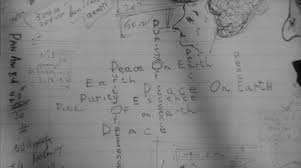I got a nice note from Ben at the excellent Melbourne Drumming Online blog (adding him to the blogroll- be sure to pay him a visit), requesting that I write something about playing in 2- that is, playing in a jazz format when the bassist is playing half notes. You know: the thing people do while they’re waiting to go in to 4. God knows I’ve done enough of it, but never much analyzed what makes it work- or not. And those who have are not really sharing, because I haven’t seen much in print about it. I’m sure if you got a lesson with Peter Erskine or Ian Froman or John Riley or Kenny Washington, they could give you some hard and fast rules/suggestions about it.
But since I’m just a field rat, and just learned it by doing it, I know of no consensus theory of playing in 2. What I’ll offer instead, then, are some strategies for going about it. For starters, here’s the basic, universal time feel, played on the hihat:
Swing the 8th notes on this and all examples, of course. Note that the cymbals open on the & of 2 and the & of 4. Go into your record collection to get an idea of the sound.
Much more- the entire body of the piece, in fact- is after the break:
Play it on the hihat, or not.
Some moderately-inexperienced bassists think playing the hihat always means 2, and playing the ride always means 4, but that’s wrong. You can play the regular ride pattern on the cymbal while the bass is in 2. Normally I would tend to emphasize the &1 and &3 of the pattern somewhat, but you can also play your normal interpretation. Here’s an example of Connie Kay playing the cymbal with a strong 2 and 4 accent:
Emphasize the &1, &3.
I tend to do this whether I’m playing brushes, the hihat, or the cymbal. You can also push that cymbal interpretation a little further, into Elvin-like territory by accenting only the & of 2 and the & of 4. The closed hihat on 2 and 4 needs to stay strong, but for a long time I would leave out the 2 and 4 on the cymbal, using this dotted quarter note/8th note rhythm:
This came from my high school band director, Greg Hall, who is a great teacher, but I don’t know where he got it, because I’ve never really heard it consistently applied anywhere else. That’s fine. I’m all for things happening by accident or as the result of partial information.
Really though, playing in two is a good opportunity to take a close look at the importance of each part of the time- the 1 and 3, the 2 and 4, and the &s of 2 and 4 .
Play the bass drum on 1 and 3.
Maybe mixing it up with &1/&3. Keep it light- just feather it in. Contrary to my stated aversion to keeping time with the bass drum, getting your snare drum comping together with the bass drum playing in two is really helpful. There is traditionally a little bit of a “boom-chuck” element you should understand, and be able to make without sounding or feeling hokey. My usual caveat about using the bass drum applies: don’t play it mindlessly and don’t use it as a crutch.
Make two or four measure phrases with your time.
A little stronger than you should when playing in 4. A lot of people do this by playing a quarter note on four of the last measure- on an open hihat, say:
Or with a triplet at the end:
You’re walking a fine line with either one of those very elementary moves- don’t be too repetitive with them. Some bassists will mindlessly put a quarter note on 4 every two bars, and if you get too in sync with that, it’s going to sound… well, bad. Hopefully you’ll find a more subtle way of making the phrase happen. I personally tend to throw them in occasionally at places other than the end of the two or four measures. You can also do this with your comping, or with the whole instrument, Elvin-style, when appropriate.
A little more sophisticated approach- and a good avenue for letting in some more modern ideas, taking the Elvin thing a little further, is to phrase the two measures in 3+3+2/4:
You can extend that to a four measure phrase as well. Treat this loosely- the effect you’re seeking is an open feel, not a metric modulation.
These are all just starting places- applying them too regularly, without listening to a lot of music and without using your head and especially your ears will make you sound very square indeed. Some, all, or none of these may work with different players, situations, tunes, and tempos, so avoid playing formulaicly (is that a word?), treat every occasion of playing in two like it’s something special, and try to figure out what’s going to work at the moment.
Finally, here’s how Roy Haynes handles a tune played almost entirely in two.
And here’s an example of a modern, very open two from Bill Evans.






